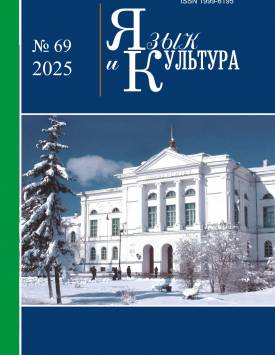Communicative-speech situations: traditional approaches – new tasks (Russian as a foreign language)
The purpose of learning any foreign language is the formation of skills that ensure participation in natural communication in the language being studied. Situational orientation is one of the most important principles of communication-oriented learning. Speech communication training takes place on the basis of communication situations. Changing the parameters of real socio-cultural communication makes it necessary to analyze communication situations at the present stage in order to adjust existing regulatory documents, educational and control materials on Russian as a foreign language. The purpose of the study is to determine the relevance of using communication situations in modern socio-cultural conditions, presented in regulatory documents and mandatory for assimilation when foreign citizens reach the first certification level of proficiency in Russian (B1). To achieve this goal, the authors used the following methods: the method of observation, questioning, comparative analysis, systematization and generalization. The survey involved 48 foreign students of the Peoples' Friendship University of Russia and Peter the Great St. Petersburg Polytechnic University. The survey made it possible to identify which communicative tasks were relevant for foreign students in direct speech communication, which communicative tasks were rarely solved by them, and which communicative tasks in the presented communication situations they practically did not solve in real oral communication due to the use of Internet resources. The results of the survey showed that the respondents used the entire set of intentions, however, the frequency of using a set of communicative tasks in situations was different. The most active respondents participated in communication in communication situations related to their educational activities. Thus, an average of 98% of respondents noted the situation “In the classroom” as a frequency, while 100% of students noted the need to solve certain communicative tasks in this situation. Communication of foreign students in health-related situations (“At the doctor”, “At the pharmacy”) remains relevant. In these situations, foreign citizens solved almost all the communicative tasks and mainly in personal communication. The results of the survey demonstrated in which communication situations foreign students actively use the possibilities of Internet resources. Thus, the tasks of obtaining information about cultural events (place and time of the event), information necessary for traveling around the city and over long distances (buying tickets for different types of transport, finding cheap tickets, orientation in the city, calling a taxi, etc.) are solved by foreign phones using various electronic applications, and not in direct communication. The survey of respondents showed that in some communication situations, the set of communicative tasks has changed due to changes in the parameters of the sociocultural context. So, in the situation “In the bank” there is an expansion of the set of communicative tasks, and in the situation “At the post office” there is a reduction in them. The results of the survey are an indicative basis for adjusting the set of communication situations presented in the regulatory documents on Russian as a foreign language (level B1), lexical content of communicative tasks, taking into account the relevance of their functioning in modern society. The results of the survey made it possible to identify situations in which foreign students carried out direct communication and situations in which Internet communication completely or partially displaces personal speech communication. Changes in the set of communicative tasks of modern speech communication were determined, as well as the frequency of foreign speakers addressing communication situations highlighted in the study. In addition, the results of the study will allow methodologists to comprehend the form and method of presentation of language and speech material serving a particular situation, to correct the system of tasks, that is, to attribute a certain situation to the format of grammatical tasks or use it as a basis for teaching communication in a real socio-cultural situation. Russian as a foreign language based on materials reflecting the current extralinguistic situation contributes to the success of the formation of the communicative competence of foreign students, adaptation to new living and learning conditions, and increased motivation to learn Russian. The authors declare no conflicts of interests.
Keywords
Russian as a foreign language, the situation of communication, the level of proficiency in Russian as a foreign language (B1), communicative tasks of a foreign languageAuthors
| Name | Organization | |
| Baranova Irina I. | St. Petersburg Peter the Great Polytechnic University | baranova_ii@spbstu.ru |
| Baryshnikova Elena N. | Peoples' Friendship University of Russian of Patrice Lumumba | baryshnikova-en@rudn.ru |
| Ivanova Anna S. | Peoples' Friendship University of Russian of Patrice Lumumba | ivanova-as@rudn.ru |
References

Communicative-speech situations: traditional approaches – new tasks (Russian as a foreign language) | Yazyk i Kultura – Language and Culture. 2025. № 69. DOI: 10.17223/19996195/69/1
